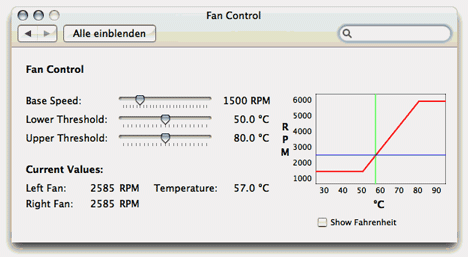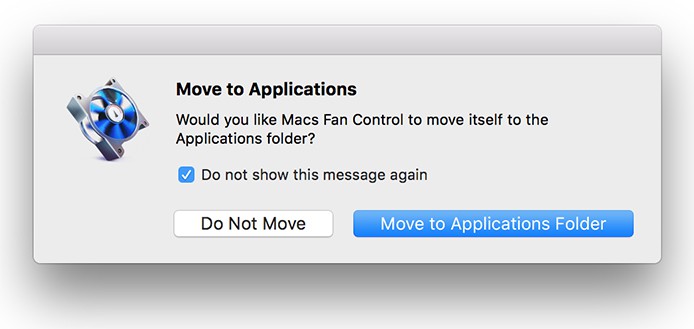There are two enemies of computer hardware: dust and heat. While it’s possible to blow out the dust on a weekly basis if necessary, controlling heat is quite another matter.
- Fan Speed Control For Mac Download
- Fan Speed Control Macbook
- Fan Speed Control For Mac Windows 7
- Macs Fan Control Bootcamp
- Fan Speed Control For Macbook
SSD Fan is an open-source fan speed controller, which gives you the overall control of your Mac computer’s fan speed. It features a daemon that runs in the background, and it makes speed configuration and temperature monitoring easy. Fan Control Software for Other Platforms. Late 2012 Mac mini 6,2 Fan Speed Control & Temp Sensors SamHamwich Apr 28, 2020 10:04 AM I'm running ESXi 6.7 U3 on a late 2012 Mac mini 6,2 (i7/16GB) and cannot seem to find any way to monitor the temperature or fan speed on my host.
When computer components, such as CPU, GPU, disks etc become hot, their performance degrades quickly and the components can even be damaged.
This is where the fans of a computer’s case or CPU along with fan speed control software are helpful in lowering heat to acceptable levels.
Such fan control software allows you to take control of the fan speed, create profiles of fan performance etc.
In this article we have curated the top fan control software apps that can work for Windows or MAC computers, laptops, or even vendor specific apps that provide a wide range of additional features.
Let’s have a look at our list (in no particular order):

Table of Contents
1) SpeedFan
Speedfan is probably the most popular fan control software and is also free.
It is for those who want all of their information presented without fuss or favor. It can monitor fan speeds and automatically change fan speeds in accordance with heat, but it can do a lot more too.
Speedfan is for those who really want to keep an eye on system performance and on various peripheral components.
It will monitor temperatures across supported components of the motherboard, such as the GPU and CPU. It can even access data from S.M.A.R.T and display the temperatures of connected peripherals such as hard disks also in addition to monitoring voltages and much more.
It works on almost all flavors of Windows starting from Win 9.x up to Windows 10.
2) NoteBook Fan Control
Notebooks/laptops can get hot very quickly because all of the components are bunched up together in a small chassis.
If you’ve ever wanted to keep an eye on your Notebook’s CPU temperature and get more out of the internal fans, NoteBook Fan Control is well worth a look.
It features a simple interface that doesn’t get in the way. You’re presented with CPU temperature and a number of fan speed presets that help you to get started. The software hides as an icon in the tray so it’s not always in front of you.

The good news is that this software already supports big name brands such as Dell, Lenovo, Acer, Asus, and more. This means that it will integrate perfectly with a wide range of laptops and notebooks.
This is another free tool as well.
3) Argus Monitor
The aptly named Argus Monitor is a sophisticated piece of software that presents information in a convenient and attractive manner.
Fan Speed Control For Mac Download
It provides granular control over CPU and GPU fan speeds and will also connect with S.M.A.R.T and display the health status and temperature of hard disks and other drives. You even get a tool that gives you access to common SSD and HDD performance benchmarks.
Apart from being able to monitor heat, you can control fan speeds, keep an eye on CPU performance, frequency and temperature, and provide crucial information on the health of your connected drives. This is useful because it is designed to warn you before a drive failure occurs.
The tool offers a 30-day trial period. After that you need to buy a license which is around $9.90 per year.
4) EasyTune 5 from Gigabyte
Easytune 5 is an attractive looking piece of software that presents all information in an easy to read way, and is focused on Gigabyte motherboards.
One thing that many people like to do is overclock their CPUs so that they get more power and speed from their computer systems. Easytune 5 makes this a complete cinch. Just click the button to the right, and you’re set to go.
You can also easily access settings for fan CPU speed control (under the “smart-fan” section), and set the RPM (Revolutions per Minute) of the CPU fans. You can even set a timer of on/off if your motherboard is equipped with the North-Bridge cooling fan.
There are also two modes: Easy and Advanced. It’s best to stick to easy mode first of all and then move to advanced mode when you’re ready to tweak other crucial settings, such as RAM boosting etc.
5) HWMonitor
HWMonitor is a hardware and temperature monitoring program aimed at enthusiasts and those who like things for free.
It works on Windows and comes in 32 and 64 bit versions. It also supports thermal readings and overclocking for the latest AMD and Intel CPUs.
In fact, the software’s homepage even features a hall of fame table for those who have managed to successfully overclock their systems up to astounding amounts!
HWMonitor allows you to get a readout on the temperature of various supported areas of the motherboard, including CPU, GPU, and attached disks. There is also fan RPM monitoring and S.M.A.R.T reading functionality for disks (no fan control however).
6) Corsair Link
Corsair Link is an amazing piece of software that is very sophisticated and includes a lot of information for Corsair systems.
Despite this, it retains an attractive, clear, and easy to understand interface that allows you to see everything you need at a glance, including core temperatures, fan speeds, SSD and HDD temperature and health status, and more.
In the Corsair Link system, everything is effectively feeding information to the software. Your case fans, motherboard fans, drives, CPUs, and GPUs, and even LED lighting strips are connected to the software.
The software even features a page that shows you exactly where these components are in a graphic of your case.
Though Corsair Link does support multiple vendors, you are going to have the best and most complete experience with Corsair components in your system. This will ensure complete monitoring performance and control.
7) Macs Fan Control
So far, there has not been much in the way of fan speed control and temperature monitoring for Mac computers, but Macs Fan Control changes that.
It is for MacOS Sierra or later, and offers real-time monitoring of fan speeds and temperature of components. Since S.M.A.R.T is also included on Mac, you also have access to the health status of connected drives.
This software may not have all the complexities of Corsair Link, for example, but it presents everything most people will need for their MAC system.
You can set for example the RPM speed of fans in relation to a temperature sensor.
8) MSI Afterburner
Afterburner is another vendor-specific tool like corsair link before.
Fan Speed Control Macbook

MSI has long been known as a manufacturer of top quality motherboards and other computer products. Afterburner is for those who want to get the most out of their GPUs and their systems as a whole. It also supports a wide range of other graphics cards.
Computer gamers often need high-end systems to run graphics and process heavy games smoothly and without glitches.
This is also why modern GPUs take up a large “real-estate” on the motherboard and need their own set of fans and heatsink configurations to keep cool. This is also why modern GPUs can also be overclocked to provide more speed.
The problem is that overclocking the graphics card introduces more heat into the system. MSI Afterburner not only allows you to increase the voltage and clock frequency of your GPU, but it also allows you full control of fan cooling.
The attractive display includes also information on CPU and other connected devices in addition to the above features.
9) smcFanControl for MAC
smcFanControl is a no-frills application that is tiny. If your Mac computer has been running hot lately, smcFanControl gives you the option to set a minimum RPM for your case fans. This means that your fans will never drop below the set speed, ensuring that your Intel Mac runs as cool as possible, even in the heat of summer.
10) ZOTAC FireStorm
ZOTAC has been making waves with their attractive range of custom MEK gaming PCs and Zbox mini PCs. Firestorm follows in the ZOTAC tradition of ultimate performance.
The first thing you’ll notice is that Firestorm features an amazing futuristic interface. Everything you need is displayed right up front in a view that would not look out of place in the latest HALO game.
Whether you want to fine tune the speed of your graphics card, the memory clock, or CPU voltage and frequency, Firestorm puts it all right at your fingertips.
The included Active Fan Control allows you to choose from multiple fan profiles so that you can balance fan noise and computer performance. You also get real-time information on health status, temperature, RAM, and CPU and GPU speeds and resource allocation for Zotac graphics cards.
11) TPFanControl
The ThinkPad line of laptops has been around for a long time, and the TPFanControl utility has been designed specifically for it. With this small utility, you get easy-to-access information right in your tray about fan speeds, CPU and GPU temperatures.
TPFanControl supports the T4x series of ThinkPad laptops, and has been designed from the ground up to provide ThinkPad users with an open source utility that allows them to easily deal with fan speed issues and keep their laptop components cool and performing optimally.
12) HWiNFO
If you want a completely free fan control utility that supports both Windows and DOS (from Windows 95 all the way up to Windows 10), HWiNFO is a very good piece of software.
Indeed, many free versions skimp on the aesthetics, but not in this case. HWiNFO presents accurate information about your system in an easy-to-read display with color-coded graphs.
This software has such an illustrious history that even NASA has used it to check for failure of computer components in high radiation fields.
Unlike many system diagnostic tools, HWiNFO provides real-time data across a wide range of internal components. This gives you an accurate picture of your system at any time, and can help to predict system or component failures with a high degree of accuracy.
If you want to dig deep and drill right down into fine and granular detail, HWiNFO provides that option too. You can see all hardware components, as well as subsystems, in great detail and also their health status and temperature where supported.
Unlike other free hardware monitor tools, this one can also control the speed of your system’s fans as well. However, this capability is supported on few systems such as Dell, Alienware etc at the time of this writing.
Related Posts
iStat Menus can help control the speed of fans in your Mac. iStat Menus can’t lower fans below the speed the System Management Controller (SMC) would normally use, but it can raise the fan speeds.
There are four main modes of fan control in iStat Menus.
- Let the system control fan speeds.
- Fan sets.
- Automatic fan set switching.
- Manual fan speed sliders in the Fan menu in the sensor menubar item.
System Controlled fan speeds #
With the fan control set to System Controlled from the Sensor menu, iStat Menus will not control fans at all — your Mac’s fans will act as if iStat Menus is not installed.
Fan sets #
If you’d like to create a set of fan speeds that can be recalled at any time, this can be done with fan set. To create a fan set:
- Open the iStat Menus app and go to the sensors tab.
- Click Edit Fan Rules.
- Click the + to the top left.
This will create a fan set. You can now edit the various fan speeds you’d like for this set. To recall the set, choose it from the Fans menu in the sensor menubar item.
Automatic fan set switching #
iStat Menus can switch to a different fan set, based on rules you provide. That will let you create a set for normal operation, and also create fan sets to be used under different circumstances. To use automatic fan set switching, choose Automatic from the Fans menu in the sensor menubar item.
To create rules for automatic fan set switching:
- Open the iStat Menus app and go to the sensors tab.
- Click Edit Fan Rules.
- Click the + to the right side of the window.
- Edit the rule to suit what you are after.
Fan Speed Control For Mac Windows 7
In the example above, iStat Menus will use “My Fan Set” when any sensor is above 80ºC. Using automatic fan set rules, you can increase the speed of fans when certain events are triggered. This means it is possible to do many things, including:

- Have a higher idling fan speed when plugged into mains power.
- Trigger higher fan speeds faster than the system would, when there is high CPU usage.
- Trigger higher fan speeds faster than the system would, when there is high GPU usage.
Macs Fan Control Bootcamp
The Default Fan Set popup button chooses which fan set will be used normally (when none of the automatic fan set rules are met).
Manual fan speed sliders #
Fan speeds can be set directly via the sliders in the Fans menu in the sensor menubar item. If the manual fan speed sliders are edited, those speeds will be used.
Please note that manual fan speed slider settings are not saved across reboots. For more permanent settings, please use fan sets.
Fan control issues #
Fan Speed Control For Macbook
If you’re experiencing issues with fans, Resetting your SMC may fix the problem.
